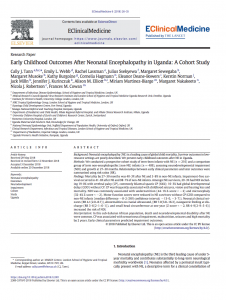
Abstract
Background
Neonatal encephalopathy (NE) is a leading cause of global child mortality. Survivor outcomes in low resource settings are poorly described. We present early childhood outcomes after NE in Uganda.
Methods
We conducted a prospective cohort study of term-born infants with NE (n = 210) and a comparison group of term non-encephalopathic (non-NE) infants (n = 409), assessing neurodevelopmental impairment (NDI) and growth at 27–30 months. Relationships between early clinical parameters and later outcomes were summarised using risk ratios (RR).
Findings
Mortality by 27–30 months was 40·3% after NE and 3·8% in non-NE infants. Impairment-free survival occurred in 41·6% after NE and 98·7% of non-NE infants. Amongst NE survivors, 29·3% had NDI including 19·0% with cerebral palsy (CP), commonly bilateral spastic CP (64%); 10·3% had global developmental delay (GDD) without CP. CP was frequently associated with childhood seizures, vision and hearing loss and mortality. NDI was commonly associated with undernutrition (44·1% Z-score b −2) and microcephaly (32·4% Z-score b −2). Motor function scores were reduced in NE survivors without CP/GDD compared to non-NE infants (median difference −8·2 (95% confidence interval; −13·0, −3·7)). Neonatal clinical seizures (RR 4.1(2.0–8.7)), abnormalities on cranial ultrasound, (RR 7.0(3.8–16.3), nasogastric feeding at discharge (RR 3·6(2·1–6·1)), and small head circumference at one year (Z-score b −2, RR 4·9(2·9–5·6)) increased the risk of NDI.
Interpretation
In this sub-Saharan African population, death and neurodevelopmental disability after NE were common. CP was associated with sensorineural impairment, malnutrition, seizures and high mortality by 2 years. Early clinical parameters predicted impairment outcomes.
Access the original article and any supplementary material here.